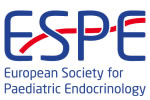hrp0094p2-264 | Growth hormone and IGFs | ESPE2021
Growth hormone (GH) treatment of children with idiopathic short children (ISS) with normal insulin-like growth factor-1 (IGF-1) versus those with low IGF-I at diagnosis.
Elsiddig Sohair , Soliman Ashraf , Alaaraj Nada , Khalil Ahmed , Ahmed Hannah ,
hrp0094p2-265 | Growth hormone and IGFs | ESPE2021
Growth response to growth hormone therapy in growth hormone deficient (GHD) children in relation to the distance between their height SDS (HtSDS) and their mid-parental height.
Elsiddig Sohair , Soliman Ashraf , Alaaraj Nada , Khalil Ahmed , Ahmed Hannah ,
hrp0094p2-266 | Growth hormone and IGFs | ESPE2021
Linear growth and response to GH therapy in children with short stature with normal Growth hormone secretion: Comparison between children with delayed versus no delay in the bone age at diagnosis.
Elsiddig Sohair , Soliman Ashraf , Alaaraj Nada , khalil Ahmed , Ahmed Hannah ,
hrp0094p2-267 | Growth hormone and IGFs | ESPE2021
Linear growth and response to GH therapy in children with GHD with normal IGF-I versus those with normal GH secretion associated with low IGFI at presentation.
Elsiddig Sohair , Soliman Ashraf , Khalil Ahmed , Alaaraj Nada , Ahmed Hannah ,
hrp0094p2-268 | Growth hormone and IGFs | ESPE2021
Growth response to growth hormone therapy in short children in relation to their distance from mid-parental heights (MPHt).
Elsiddig Sohair , Soliman Ashraf , Alaaraj Nada , Khalil Ahmed , Ahmed Hannah ,
hrp0095rfc6.6 | Sex Development and Gonads | ESPE2022
Differently Normal: Making sense of Adolescent Perspectives of Early Childhood Experiences associated with Congenital Adrenal Hyperplasia (CAH)
Siese Thomas , Alderson Julie , Hickingbotham Hannah , Hawton Katherine , Skae Mars , Crowne Elizabeth
hrp0095t14 | Section | ESPE2022
CCDC149: a Novel Gene Associated with Multiple Pituitary Hormone Deficiency
Rath Shoshana , Elias-Assad Ghadir , Abozaid Said , Nasser Samra Nadra , Mandel Hannah
hrp0095p1-456 | Diabetes and Insulin | ESPE2022
Outmoded by Mody? A Case Report of HNF1A-Mody in Paediatric Stroke
Siese Thomas , Hickingbotham Hannah , Eggers Anne , Alins-Sahun Yolanda , Bowen Philippa , Hamilton-Shield Julian
hrp0095p1-79 | Fat, Metabolism and Obesity | ESPE2022
Severe early-onset obesity and diabetic ketoacidosis due to a novel homozygous c.169C>T p.Arg57* mutation in CEP19 gene
Cayir Atilla , Turkyilmaz Ayberk , Rabenstein Hannah , Guven Fadime , Sumeyra Karagoz Yuksel , Wabitsch Martin , Demirbilek Huseyin
hrp0095p1-135 | Multisystem Endocrine Disorders | ESPE2022
Hypoaldosteronism without hypocortisolism - an unusual presentation of APECED syndrome
Gounari Eleni , Buchanan Charles , Ghataore Lea , Hannah Romanie , Bushan Arya Ved



